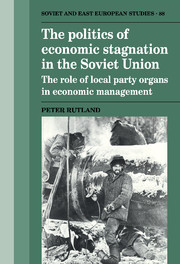 The Politics of Economic Stagnation in the Soviet Union
The Politics of Economic Stagnation in the Soviet Union Book contents
- Frontmatter
- Contents
- List of tables
- Preface
- Glossary of Russian terms and abbreviation
- Introduction: The party in the post-totalitarian system
- 1 The party and the economy: structures and principles
- 2 Party interventions in industry
- 3 Interventions in industry: case studies
- 4 The party as regional coordinator
- 5 Regional coordination: case studies
- 6 The party as fireman: party interventions in the transport and energy sectors
- 7 The role of the party in agriculture
- 8 Non-party control organs
- 9 The principles underlying the party's work with cadres
- 10 The obkom elite in the 1980s
- 11 Party and economy under perestroika
- Conclusion Party and economy in the USSR: from stagnation to collapse
- Appendices
- Notes
- Bibliography
- Index
- THE POLITICS OF ECONOMIC STAGNATION IN THE SOVIET UNION
1 - The party and the economy: structures and principles
Published online by Cambridge University Press: 06 July 2010
- Frontmatter
- Contents
- List of tables
- Preface
- Glossary of Russian terms and abbreviation
- Introduction: The party in the post-totalitarian system
- 1 The party and the economy: structures and principles
- 2 Party interventions in industry
- 3 Interventions in industry: case studies
- 4 The party as regional coordinator
- 5 Regional coordination: case studies
- 6 The party as fireman: party interventions in the transport and energy sectors
- 7 The role of the party in agriculture
- 8 Non-party control organs
- 9 The principles underlying the party's work with cadres
- 10 The obkom elite in the 1980s
- 11 Party and economy under perestroika
- Conclusion Party and economy in the USSR: from stagnation to collapse
- Appendices
- Notes
- Bibliography
- Index
- THE POLITICS OF ECONOMIC STAGNATION IN THE SOVIET UNION
Summary
This chapter investigates the principles underlying party interventions in the economy, and the institutional apparatus through which such interventions took place. The CPSU saw itself, according to Article 6 of the 1977 Constitution, as ‘The leading and guiding force of Soviet society and the nucleus of its political system and of all state and public organizations.’ This involved responsibility for the whole range of social and political activity, from child-rearing to national defence. Within this spectrum of involvement, economics played a pivotal role.
In the Brezhnev era the party pledged to put the USSR through ‘accelerated socio-economic development’ so that they could further perfect ‘developed socialism’. This involved the party in both the ‘leadership’ (rukovodstvo) and ‘direction’ (napravlenie) of Soviet society: setting the general goals for social development and taking concrete steps to ensure that they are brought to fruition. This meant that the CPSU committed itself to active involvement in the economy. When Soviet writers talked of obeying the ‘laws of social development’ or a ‘scientifically based economic policy’ they were not suggesting a hands-off approach. Socio-economic laws, unlike the laws of physics, would not unfold by themselves, but required active human involvement. The Brezhnev leadership made great play of its ‘scientific’ approach to social problems, using this to distinguish its own interventions from Khrushchev's ‘voluntaristic’ interference.
- Type
- Chapter
- Information
- The Politics of Economic Stagnation in the Soviet UnionThe Role of Local Party Organs in Economic Management, pp. 24 - 48Publisher: Cambridge University PressPrint publication year: 1992


